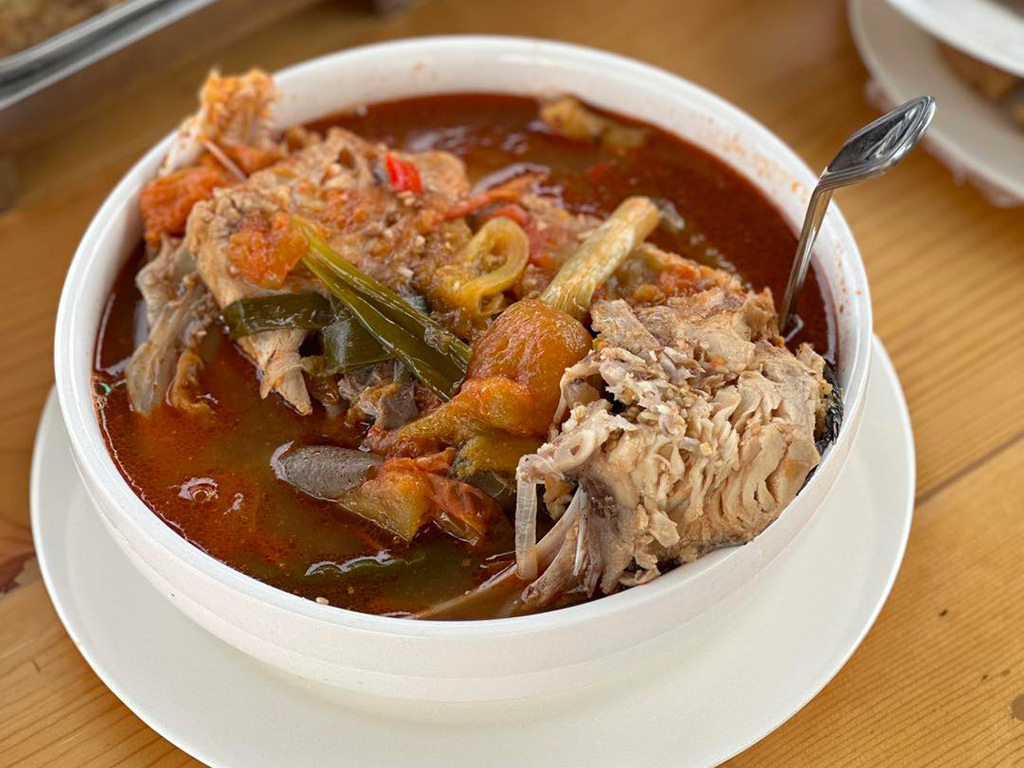Larang is a fish stew that is made with a coconut-milk based broth.
(Photo courtesy of No Problem STK Facebook page)
Cebu is, without a doubt, a seafood haven.
Sutukil dishes have inspired countless restaurants around the island, giving customers three different ways to enjoy their favorite seafood meals.
However, this popular concept is notable not just for the three different ways the food is cooked, but also for the ingredients used.
Larang or linarang is a local fish stew, often compared to ginataan because of its use of a coconut-milk based broth. The sour taste is taken from the tomatoes, garlic, red onions, and other spices.
The main ingredient for this exotic dish, however, is parrotfish. Sometimes, they add eels too!
If you ask around, you may also find other versions of larang, where they use meat from sharks, stingrays, and puffers. These are usually sold in unassuming carinderias that mostly operate at night, with a few operating 24/7.
The hot stew is considered by many as a go-to hangover cure, as some variants are in a way considered aphrodisiacs that will keep you up at night.
It has gained the attention of Cebu’s residential areas, especially travelers looking for the best exotic food in the Philippines. It’s a delicacy that perfectly encapsulates the country’s unique culinary culture.
LARANG IN CEBU
To order this iconic fish stew, start with the type of fish you want. The most commonly used is molmol (parrotfish), and other variations include tanguigue (Spanish mackerel), rompe (barracuda), and malasugui (marlin).
However, tagotongan (porcupinefish) is the most popular variant you will find at larang restaurants in Cebu City, especially in Pasil.
This downtown Cebu neighborhood has many larangans, since it houses the city’s biggest seafood market. This is where fish vendors trade and buy the freshest catches at night up until the early hours of the morning.
Some larangans also use pufferfish.
In Cebu, there is an abundance of two types of puffers, namely: butete (balloonfish) and the aforementioned porcupinefish. Both variants have tetrodotoxins, which can be lethal when consumed.
An article from Business Insider says that a human can only ingest less than 1.5 milligrams of the toxin, so eating a large concentration of it can be fatal.
Since the balloonfish has a higher amount of toxins, it isn’t used for larang. In fact, it is no longer sold by fishermen after several customers have died consuming this type of puffer.
On the other hand, tagotongan has 10 times less tetrodotoxins, which humans can resist a bit better.
Studies also show that there are benefits to consuming larang with lower toxin levels, as it can treat pain like morphine, which is why many would feel energized after eating it.
Vendors skin the porcupinefish and remove the scales carrying the toxins. These are then dunked into a coconut-milk based broth, with a few vegetables and spices added in for extra flavor.
Larangans usually serve their fish stew with rice, but many recommend pairing it with bugas mais, which is a popular rice alternative. You can pour the broth onto the rice to complement the grainy texture.
Customers have compared the broth to sinigang because of its sourness, and the pufferfish tastes like a mix of chicken and white fish meat. It may seem a bit bizarre at first, but a few sips and bites in and you will definitely get used to the taste.
Larang is a popular exotic dish and Filipino street food delicacy that you should try when visiting Cebu. Puffers may not be the most ideal kind of fish to eat, but larang has continued to defy expectations.
Take a short trip to Pasil and try out this exotic dish yourself. Look and ask around for the best larang in Cebu, and you might find a stew made with the most unlikely of ingredients.






